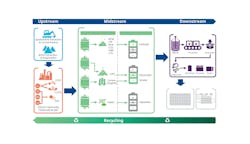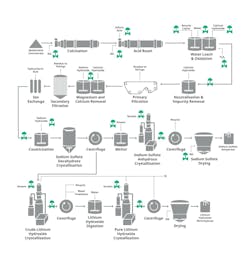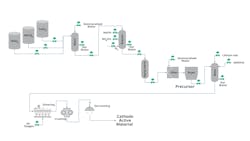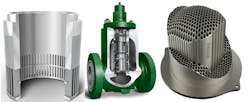Control valve selection for the lithium battery value chain
As the world continues to focus on greenhouse gas reduction and sustainability, it has become clear that lithium batteries will play a dominant role. Electric vehicles provide an immediate means to reduce the carbon footprint of the automotive and transportation sectors, which account for 11% of global emissions. The power industry accounts for an additional 23% of emissions, but that can be reduced utilizing high-density battery energy storage systems to offset the variability of green energy sources, such as solar and wind.
Lithium batteries consist of lithium, nickel, cobalt and manganese, and all these products must be mined, refined and ultimately processed to create a lithium battery. The lithium battery value chain begins with mining and ore concentration, extends through chemical processing and refining, and finishes with battery production. However, lithium battery recycling is quickly becoming a critical part of the process as well.
This article describes the various stages of the lithium battery value chain and discusses the challenges those processes pose due to erosive slurries, corrosive chemicals and a need for very tight control. Control valve selection can be quite difficult for these applications, but wise choices are necessary to ensure efficient, reliable and safe operations.
Lithium battery demand
The global demand for lithium carbonate equivalent (LCE) has been growing rapidly, a trend that is expected to continue, and accelerate (Figure 1). Lithium reserves are often measured using LCE, which allows different types of lithium compounds to be compared.
Since lithium is a major component of lithium batteries, it is demanded in increasing quantities as electric vehicles become more common, and as electric trucks are now becoming available. The power industry is also driving demand because lithium batteries offer a means for storing and leveling the production of variable solar and wind energy.
Lithium batteries also contain nickel, cobalt and manganese. While lithium provides the proper electrochemistry and electrons that power the battery, cobalt and manganese are necessary for the cathode side of the battery, and nickel is needed to improve energy density and storage capacity. As a result, the demand for all these materials is growing. The lithium value chain includes upstream, midstream and downstream processes, as well as the nascent recycling processes (Figure 2).
Control valves play an important role in all these areas, but upstream, midstream and recycling processes involve many difficult applications that pose significant challenges.
Lithium process control valves
Like most mining activities, the upstream area consists of the typical slurry and ore extraction processes that include erosive process streams, corrosive chemicals and heating processes requiring tight natural gas and air controls (Figure 3).
The midstream area contains slurries, precipitators and solids handling (Figure 4).
For both upstream and midstream, some of more critical control valves for both upstream and midstream are shown in Figures 3 and 4, which describe the typical process steps in lithium hydroxide and cathode production facilities.
Control valve selection will always depend upon the flows, pressure drops and specific material of construction demands of a particular process. For the upstream and midstream areas, erosive slurries are common and will typically require an eccentric plug control valve, such as the Fisher V500 Eccentric Plug Valve furnished with high hardness trim materials, like R30006 Stellite, CoCR-A hardfacing and very tough ceramic (VTC). The eccentric valve design (Figure 4) with hardened trim avoids plugging and directs the erosive force of the process away from the more sensitive valve sealing areas.
Another common application for these areas requires tight flow control of highly corrosive liquids, such as strong and weak acids and bases. For these types of processes, proper material selection is paramount, so an accurate and thorough understanding of the types and concentrations of the chemicals present in the flow streams is critical. Once the chemistry is understood, the correct body and trim materials can be selected, and an appropriate valve style chosen (Figure5). A Fisher E-series or Fisher GX control valve will provide tight controllability across a wide flow range, and body and trim materials like Alloy 20, Monel, Hastelloy C and Duplex are available to handle the corrosive process conditions.
Very tight control of process flows is critical throughout the value chain. Proper flow control drives energy efficiency for the process heating needed with calcination and acid roasting, and many of the reactor processes demand precise flow control of raw material and reactants to maintain product quality. For these applications, properly sized sliding stem valves, such as the Fisher easy-e EZ Control Valve and GX control valves paired with a Fisher FIELDVUE Digital Valve Controller, provide the required high level of performance. For critical applications, this type of high diagnostic positioner can provide advanced indication of impending problems and avoid unplanned downtime.
Certain areas of these processes will experience high pressure drops, which can cause cavitation and flashing. In these circumstances, valve trim selection must be carefully considered to extend service life and avoid unplanned downtime. A wide selection of rising stem anti-cavitation trims is available. Anti-cavitation trim specification is relatively straightforward for clean services, but dirty, plugging, and three-phase flow applications can be more challenging. Fortunately, there are specialized valves and trims, such as the Fisher Dirty Service Trim (DST) and Fisher Cavitrol Hex Trim designs, which are well suited to handle cavitation prone processes in dirty applications, or for systems employing rotary valves (Figure 6).
Lithium recycling
Currently, many spent lithium batteries end up in landfills as there are few active lithium battery recycling programs available worldwide. However, the industry is working hard to rectify this limitation, and several companies are actively developing commercial recycling processes and building plants across the globe.
Recycling typically uses one of three processes. Pyrometallurgy crushes and melts down the batteries, and it then separates the minerals for reuse. Hydrometallurgy crushes the batteries and uses chemical processes such as leaching and solvents to extract and purify the reusable minerals. Direct recycling methods usually deconstruct the battery to remove the reusable parts. Dismantling the battery is more difficult, but the resulting materials contain far fewer contaminants and are therefore much easier to process using a variety of methods.
Like upstream and midstream processes, recycling operations may involve slurries, corrosive chemicals and a requirement for tight control, and the control valve suggestions in those areas generally also apply here.
Conclusion
The entire lithium battery value chain is dependent on reliable control valves to ensure product quality, reliable and extended service life, and safety. There is often a wide selection of control valve designs and options available, and certainly the price will vary considerably across those options. However, a short-sighted decision based on initial cost will often prove unwise as the true cost of shortened service life and process unreliability become obvious.
When evaluating control valve options, end users should take the time to carefully consider the requirements of the process, and then choose a valve style, the materials of construction and a positioner best suited to handle the conditions and provide reliable performance. The broad suite of offerings can be daunting, so it may be helpful to engage a knowledgeable control valve vendor to better understand the options and help select the right valve for the application.
About the Author
Erjian Heng
Control valve business development manager for Emerson’s Flow Controls products
Heng Erjian has been working for 13 years as a control valve business development manager for Emerson’s Flow Controls products, concentrating on the chemical and power industries. He graduated from Nanyang Technological University in Singapore with a Bachelor of Mechanical Engineering degree.
KeeChong Lee
Lee KeeChong has 18 years of diverse experience at Emerson, specializing in both technical and marketing roles for Fisher FIELDVUE products. He currently focuses on driving innovation and solutions in the control valve business for the chemical processing industry. A graduate of the National University of Singapore with a Bachelor’s degree in Electrical Engineering, he combines technical expertise with strategic market insight to deliver impactful results and drive growth in the industrial automation space.






